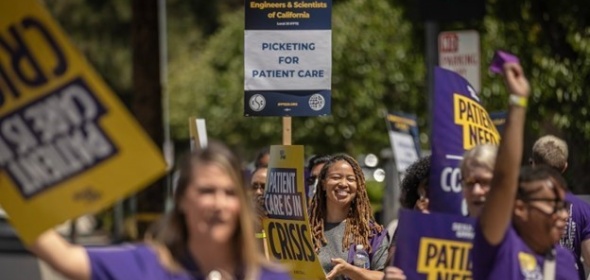By Kristen Hwang. Reprinted with permission from CalMatters. Leer en espanol.
Ashley Hooks always planned to retire at Lakewood Regional Medical Center, where she has been a nurse for 12 years. But now, Hooks said, staffing issues are so bad and burnout so severe that she’s rethinking how she wants to spend the rest of her career.
Since the COVID-19 pandemic began, the number of nurses at the hospital dropped from just below 500 to 330 according to her union’s roster, said Hooks, who is 53.
“It wasn’t even this difficult during the height of the COVID pandemic,” she said.
Hooks’ stress reflects pressure many California nurses are under because of steep understaffing that she and others say is driving many professionals out of the industry.
According to the Hospital Association of Southern California, nursing vacancy rates among local hospitals exceed 30%. Prior to the pandemic the average vacancy rate was 6%.
“Within the last year and a half or so, it’s really gotten worse,” Hooks said.
Now the Legislature is looking at several ideas to address the nursing shortage by bringing more early-career nurses into the field. But so far, the groups with most to gain — or lose — are at odds over how to solve the staffing problems afflicting California’s health care workforce.
Labor organizations and hospitals want nursing schools to prioritize certain applicants for admission, such as people who already have experience in the industry.
“We don’t have enough nurses entering the system as opportunities are opening up for them to leave the system,” said Peter Sidhu, a nurse and executive vice president of United Nurses Associations of California/Union of Health Care Professionals.
But the schools say that won’t help them graduate more nurses. They need more faculty and more hands-on training opportunities to increase class sizes.
Hospitals and unions say they don’t have much time to waste. Estimates show California faces a shortage of about 36,000 licensed nurses, according to the UC San Francisco Health Workforce Research Center on Long-Term Care.
Preliminary data from a statewide survey conducted in 2022 shows nurses cut back on the number of hours worked per week since 2020, and nearly half the workforce reports symptoms of burnout, said Joanne Spetz, director of the Institute for Health Policy Studies at UC San Francisco, who has studied nursing workforce issues for more than a decade.
More nurses, even those as young as 35, are thinking about leaving the profession entirely or retiring within the next two years, and half of the workforce had at least one patient die of COVID-19, Spetz said.
“There is a lot of trauma in the nursing workforce,” Spetz said. “The numbers are not good.”
